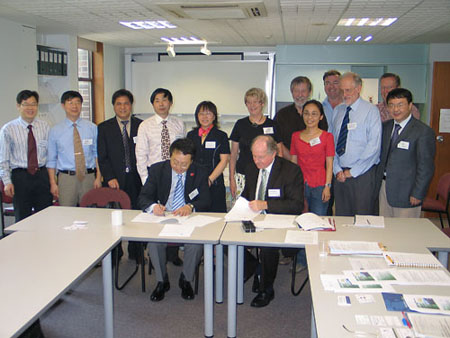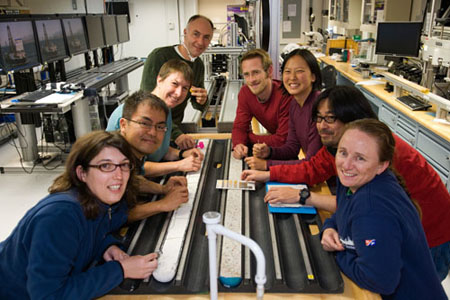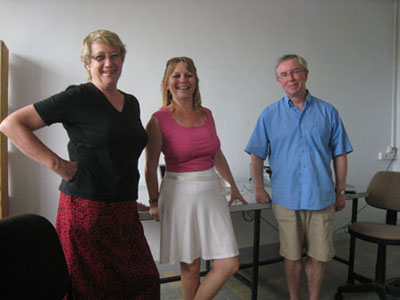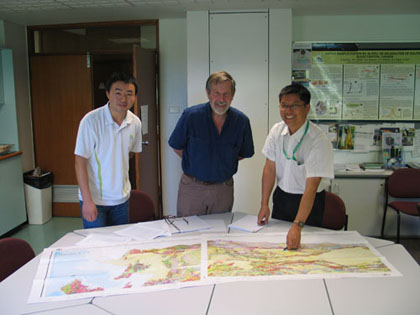GEMOC's international links
BACKGROUND
GEMOC’s international links provide leverage of intellectual and financial resources on a global scale, and an international network for postgraduate experience. International activity includes funded projects and substantial collaborative programs with exchange visiting programs in France, Norway, Germany, United Kingdom, New Zealand, Canada, USA, Taiwan, Italy, Spain, South Africa, South America, China, Brazil, Japan, Thailand and Russia.
FUNDED COLLABORATIVE PROJECTS COMMENCED OR ONGOING IN 2009 INCLUDE:
- Collaboration in the CERCAMS project (www.nhm.ac.uk/research-curation/projects/cercams/gallery.html) as part of the ARC Discovery project "Earth's internal system: deep processes and crustal consequences" (see section on Funded Research Projects). The CERCAMS project is a major study of crustal evolution across the Altaides, led by the Centre for Russian and Central EurAsian Mineral Studies at the Natural History Museum, London (Dr Richard Herrington, PI on the Discovery Project, and Dr Reimar Seltman) and involving Russian research groups, a number of industry sponsors and GEMOC.
- A new collaboration with the China Academy of Science, (Beijing) commenced involving both the Institutes of Geochemistry and Geophysics. Exchange visits for geochemical programs involved
 complementary analytical work on perovskite dating and in situ analyses of oxygen isotopes in zircon and apatite.
complementary analytical work on perovskite dating and in situ analyses of oxygen isotopes in zircon and apatite.
- A formal visit by executive from the China University of Geosciences resulted in a MOU with GEMOC, Macquarie University. A formal co-postgraduate project also commenced.
Another collaborative-PhD agreement and general MOU for collaboration is established, during a visit by a delegation from China University of Geosciences (Beijing), the home base of Jinxiang Huang (in the red shirt).
- Trace elements and fluids in diamonds and relevance to mantle fluids and processes with Professor Oded Navon (Hebrew University, Israel), Professor Thomas Stachel (Edmonton, Canada) and Dr Jeff Harris (University of Glasgow, UK).
- Shear-induced metal segregation in ordinary chondrites, a collaborative project with Professor N. Petford 2007-2009 (Bournemouth University, UK).
- The first million years of our solar system – stellar nucleosynthetic inputs, solid formation and planet building with Professor Joel Baker (Victoria University, New Zealand).
- Core formation and degassing of the Earth, a collaborative project with Dr S. Nielsen and Professor A. Halliday (University of Oxford) and Dr M. Rehkamper (Imperial College, London).
- Partitioning of chalcophile elements between metal, sulfide and silicate, a collaborative project with Dr D. Frost and Professor D. Rubie (Bayreuth University, Germany).
- Detailed 2-D and 3-D structure of the Kaapvaal Craton in several time slices, using mantle-derived xenocrysts, a collaborative project with De Beers.
- Global Lithosphere Architecture Mapping, involving analysis of crustal evolution, the composition of the lithospheric mantle and the interpretation of seismic tomography, a collaborative project with BHP Billiton and Professor Steve Grand (University of Texas at Austin).
- Dr Kelsie Dadd was one of a team of 50 international scientists who participated in a nine-week Integrated Ocean Drilling Program (IODP) expedition in the Bering Sea that recovered sediment cores sho
 wing evidence of past climate change. The drilling has shown the history of the climate and water circulation in the basin over the last five million years reflected in the type of sediment recovered, the degree to which it has been mixed by burrowing organisms, and the distribution of biogenic material.
wing evidence of past climate change. The drilling has shown the history of the climate and water circulation in the basin over the last five million years reflected in the type of sediment recovered, the degree to which it has been mixed by burrowing organisms, and the distribution of biogenic material.
Sedimentologists aboard the JOIDES Resolution during IODP Expedition 323 Bering Sea. Clockwise from front left are Gretta Bartoli, Akira Ijiri, Beth Caissie, Ivano Aeillo, Christian Maerz, Mea Cook, Hirofumi Asahi, and Kelsie Dadd.
- Collaboration with Professor Massimo Coltorti and Dr Costanza Bonadiman from the University of Ferrara on the geochemistry of amphiboles, mantle metasomatism, and the age and origin of the lithospheric mantle beneath the Cape Verde Islands and Antarctica.
- A TerraneChron® study to unravel the timing and tectonic history of regions in Tibet continued as a collaborative program with the National University of Taiwan (led by Professor Sun-Lin Chung), and has expanded to include collaboration with Nanjing University and the Tibet Institute, Beijing.
- The nature of the lithosphere in Mongolia, and lithosphere extension in the Taiwan region, with Dr Kuo-Lung Wang (Institute of Earth Sciences, Academia Sinica, Taiwan).

Sue enjoying Montpellier with Prof David Mainprice and Bernadette, the institute's administrator.
- Collaboration with colleagues at the University of Jean Monnet, St Etienne, including Professor Jean-Yves Cottin, Dr Bertrand Moine and Dr Marie-Christine Gerbe (with reciprocal funding from both sides) expanded. A formal agreement between the two universities includes PhD exchange, academic exchange and research collaboration relevant to the nature of the lithosphere in the Kerguelen Archipelago, Crozet Islands and the Hoggar region of Algeria. In addition, studies on magma mixing in granites commenced with a new co-tutelle agreement (Anne Fonfrege).
- Collaboration with colleagues at the University of Montpellier continued with two co-tutelle PhD projects (Véronique Le Roux and Yoann Gréau) and projects on the mantle budget of platinum group elements, microstuctures of meteorites and mantle rocks, and ophiolites.
- Trace elements in mineral inclusions in lower mantle diamonds from Juina, Brazil with Dr Felix Kaminsky (KM Diamond Exploration, Vancouver, Canada).
- Dr Farida Ait-Hamou from the Université des Sciences et de la Technologie Houari Boumediene (USTHB), Algeria, undertook fieldwork in Algeria to collect mantle xenoliths from the Hoggar region as part of the Hoggar strand of the Discovery Project "Earth's Internal System: deep processes and crustal consequences". Analyses of these xenoliths will be integrated with geophysical datasets to understand the origins of the Hoggar Swell, a major topographic feature of North Africa.
- Igneous rocks, mineral deposits, lithosphere structure and tectonic setting: southeastern China and eastern Australia. This collaboration with Nanjing University has expanded from an AusAID grant under the ACILP scheme with Professor Xisheng Xu (Nanjing University).
- Collaboration with Professor Yuri Kostitsyn from the Vernadsky Institute of Geochemistry and Analytical Chemistry (GEOKHI), Russian Academy of Science includes studies on continental crust formation in the modern subduction zone: Kamchatka Peninsula. Professor Kostitsyn is also involved in the GEMOC project testing models for continental crustal growth using the TerraneChron® database.
- Studies with Professor Jianping Zheng (China University of Geosciences, Wuhan) on the evolution of the lithosphere beneath several parts of China, crustal evolution in the North China Block, the Yangtze Block and southeastern China, and the UHP metamorphism of Dabie-Sulu peridotites. Dr Yuping Su from this Institute visited for 6 months' research work on related studies.
- Studies on Cathaysia's place in Rodinia, crustal evolution of southeast China, and crustal evolution of the Yangtze Block with Professor Jinhai Yu and Ms Lijuan Wang (collaborative project with Nanjing University and cotutelle program).

Dr Rendeng Shi (right) and his postdoctoral student, Mr Qiashuai Huang. (left) discussing their work with Bill Griffin, December 2009.
- Studies continued with Dr Rendeng Shi (University of Science and Technology, Hefei, China) on the age and origin of platinum group alloy phases in podiform chromitites in ophiolites from Tibet, including a research visit by Dr Shi and his postgrauate student, Mr Qiashuai Huang.
- TerraneChron® analysis of Proterozoic terrains in Africa, North America and Europe, with BHP Billiton and several other mineral-exploration companies.
- A new study on the granite magmatism, basement ages and provenance indicators in the Malay Peninsular using U-Pb and Hf isotopes from detrital zircons commenced with a research visit by Inga Sevastjanova (a postgraduate student from Imperial College)
- Age and magma sources of Chilean Cu-porphyries, with Codelco (Chile) and the CSIRO Division of Exploration and Mining (Perth).
- Several collaborative projects continued with Dr Kreshimir N. Malitch (Department of Geochemistry, All-Russia Geological Research Institute (VSEGEI), St Petersburg) including: (1) the nature and origin of zircons from the intra-continental paleorift-related ultramafic-mafic intrusions of the Noril'sk area (northern Siberia, Russia). The latter include world-class PGE (platinum-group element)-Cu-Ni sulfide deposits related to Noril'sk-1, Talnakh and Kharaelakh ultramafic-mafic intrusions, subeconomic PGE-Cu-Ni deposits related to Chernogorsk, Zub-Marksheider and Vologochan intrusions, prospective Mikchanga intrusion and non-economic Nizhny Talnakh, Zelyonaya Griva and Kruglogorsk intrusions; (2) analysis of Os-(Ir-Ru) alloy grains derived from two world-class Au-PGE placer deposits associated with the Guli clinopyroxenite-dunite massif (northern Siberia, Russia) and the Evander Goldfield within the Witwatersrand Basin (South Africa). The main aim of this study is to place further constraints on osmium-isotope signatures of the mantle sources for Os-rich alloy grains at Guli and Evander, which (along with Witwatersrand grains) represent the oldest terrestrial platinum-group minerals known so far.
- Formal visits to three Chinese institutions strengthened or initiated collaborative research projects and agreements: Nanjing University; China Academy of Sciences, Geophysical and Geochemical Institutes; China University of Geosciences (Beijing)
Refer to the Research Program and Postgraduate sections of this Report for details of other projects.

 GEMOC ARC National Key Centre
GEMOC ARC National Key Centre